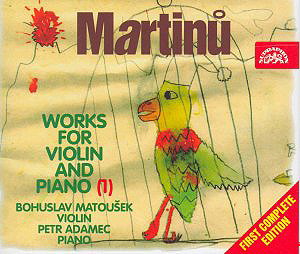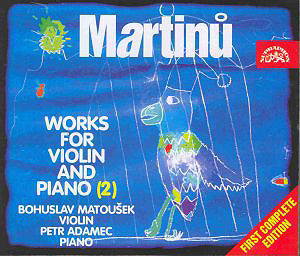Never
in a commercial release has Martinů's oeuvre for violin and
piano been attempted with such exhaustive coverage. While the
three violin sonatas have been recorded quite a few times most
of the other pieces in these two dual CD sets have stayed resolutely
out of the catalogue. And these include some pretty enigmatic
material.
Martinů's
music for violin and piano stretches from the Elegy of
1909 to the Czech Rhapsody of 1945.
Amongst
his first compositions is the 1909 Elegy with its
sub-title of 'Evil Returns'. This is music of the grandest ambition
and the melodramatic announcement by the piano suggests the composer
knew his Grieg Piano Concerto. The angry, Hispanic pomp and sturdy
pride of the violin touched also with the smoky romance of the
Ziegeunerweisen is also surprising. None of this sounds
anything like the Martinů we know. It is a most startling
piece and was not at all the salon nonentity I had suspected.
The
Elegy's passion is not carried over into the so-called
‘Concerto for violin and piano’. This instead is a triptych
of song statements with salon Dvořák and perhaps popular
Bruch in the veins. It is not to be confused with the Double Concerto
for violin, piano and orchestra of the 1950s to which it bears
no resemblance or connection at all. It is an essentially undemanding
and unambitious piece. The unnumbered Sonata in C major owes
its dues to the Franck sonata and might also be paired with the
Dunhill Second Sonata and the Goossens First … both of 1918. After
a Mephisto scherzo comes a powerful Largo and the Franckian melos
returns in flowing spate for the final Allegro. In its last minutes
the music rises to a majesty equal to that of the finale of John
Foulds’ Cello Sonata with only the merest hint of 'throaty' unsteadiness
from Matoušek.
The
second disc of volume 1 moves onwards with a work which starts
to sound more like the Martinů we know - albeit early Martinů.
The D minor sonata (still unnumbered) dates from his Parisian
years and his studies with Roussel. More importantly in the rhythmic
liveliness of the outer movements it marks encounters with jazz.
Dissonance is more in evidence than in the works on CD1. The sonata's
second movement andante cleverly uses a suave romantic theme of
the type that appeared in the H13 Concerto and the C major sonata
but disrupts it with small harmonic collisions that give the music
a dreamy disorientation. The composer is here in transition with
the baggage of his Prague studies (late romantic) mixed with the
first stirrings of individuality. The three movement Impromptu
shows an even stronger personality with three micro movements
making free with dissonance and dream states - chaffing and soliloquising
- lively and thoughtful.
The
first numbered Violin Sonata emerged at the end of his
jazz phase in 1929 and as the notewriter says picks up on the
all-conquering influence of the Rhapsody in Blue (tr.9
2.58) and does so amongst other devices through many solo passages
for the violin.
The
Five Short Pieces were dedicated to Martinů's friend
and biographer Miloš Šafránek who was cultural attaché at the
Czechoslovak embassy in Paris. Only in the rather manic allegro
vivo (tr.13) do we recognise the typical Martinů voice. They
are otherwise rather oblique and dry essays.
The
second set will be balm to the Martinu fan reeling from volume
1 with its many unfamiliarities. The Arietta starts with
a typically singing melody and matches it with a ragtime jumpiness.
From the year afterwards comes the Violin Sonata No. 2.
It is short, Stravinskian in part, active with neo-Baroque touches
especially in the heartless, machine-like allegro music which
also adds a flavour of the mephisto voice from the Sonata in C
major of 1919. A placid serenity, hymn-like, hangs over the larghetto
(tr.3) which gains additional savour from the dusting of dissonance.
The hallmark Martinů harmonies of 2.49 (tr. 3) remind us
that even amid his deeply neo-classical period the essential juices
of his blazing maturity are there.
The
Seven Arabesques are subtitled Rhythmic Etudes.
They were commissioned by Deiss, his Parisian publisher. They
can be played on either violin or cello. While the Moderato and
Allegro (trs. 6 and 8) sometimes sound a little like Dvořák's
Humoresque there is much in these didactic pieces to please.
The andante moderato is a classic example of Martinů immersed
in a dream state - no wonder he warmed to Georges Neveux's play
Julietta and turned it into an opera.
The
1937 Sonatina is designed for young players yet satisfies
in its own right with enough of Martinů's distinctive writing
to announce the work as personal. It comes from the same year
as Julietta, the String Quartet No. 4 and the Duo Concertante
for two violins and orchestra. The Intermezzo of 1937
and the 1927 Impromptu are surprisingly in multiple movements;
the 1927 work in three; the 1937 piece in four. This work is again
intended for teaching purposes but this time is pleasingly closer
to the Dvořákian salon than to world-weary or sensually ecstatic
Martinů.
The
second CD of volume 2 opens with the Rhythmic Etudes H202
from 1931. This is more interesting than anything else although
a Martinů melody floats free in the Poco Allegretto (CD2
tr.2). They are intended for advanced amateurs and the single
stave piano part is designed to leave the solo violin line artfully
exposed.
Martinů
was fond of Madrigal form and wrote many chamber works to which
he attached that title. The Madrigal Stanzas of 1943 come
from his New York years. They are dedicated to Albert Einstein
whose works he read but confessed to not understanding. Einstein
was an amateur violinist and the writing takes this into account.
That notwithstanding this is a fully personal statement and must
be heard by any dedicated Martinů enthusiast.
The
Third Sonata plays for almost a half hour. It is the most
extensive of his violin sonatas. The booklet notes the feeling
of weightlessness that pervades the Adagio (CD2 tr. 14) and this
carries over after a skittish scherzo into the dreamily sauntering
and nostalgically inclined Lento opening of the finale which gradually
becomes increasingly animated.
Martinů's
last work for violin and piano was the wistful Czech Rhapsody.
It is dedicated to the Martinůs' family friend, Fritz Kreisler.
It sings with those stepwise upwards aspirational melodies we
know from the Fourth Symphony (CD2 tr. 17, 8.20). Its temperament
is well suited to Kreisler with certain sections echoing the spirit
of Dvořák's Humoresque but its technical demands would
almost certainly have been beyond the reach of the seventy year
old violinist.
The
notes are good (allowing for a scattering of typos) as is the
recording quality. Matoušek tends towards huskiness of tone and
sometimes I thought the piano was rather backwardly recorded but
nothing seriously untowards.
The
encyclopedic emphasis of these two sets has been achieved through
funding from the Bohuslav Martinů Foundation.
What
is the role of these two sets? It is to ensure that students and
fans can follow Martinů's development. That is achieved in
remarkably chronological fashion from one set to the other and
from one disc to the next. The three sonatas have been recorded
before and Fredell Lack on Centaur is excellent in this connection
perhaps with a more generous tone than Matoušek. The Supraphons
do bring out into the sunlight some very fine works. I will certainly
return to the powerful Elegy even if it is completely atypical.
The Arietta is lovely as also is the Czech Rhapsody
which maybe shares the homesick essence of the Slovak Folk
Song Variations (cello and piano on SU 3586-2 112). The Madrigal
Stanzas and some of the Rhythmic Etudes are well worth
hearing as also are the dreamy andante moderato of the
Seven Arabesques and the Largo of the unnumbered
C major sonata.
Rob
Barnett




![]() Bohuslav Matoušek (violin)
Bohuslav Matoušek (violin)
![]() SUPRAPHON SU 3412-2
132 [2CDs: 48.49+62.00]
SUPRAPHON SU 3412-2
132 [2CDs: 48.49+62.00]